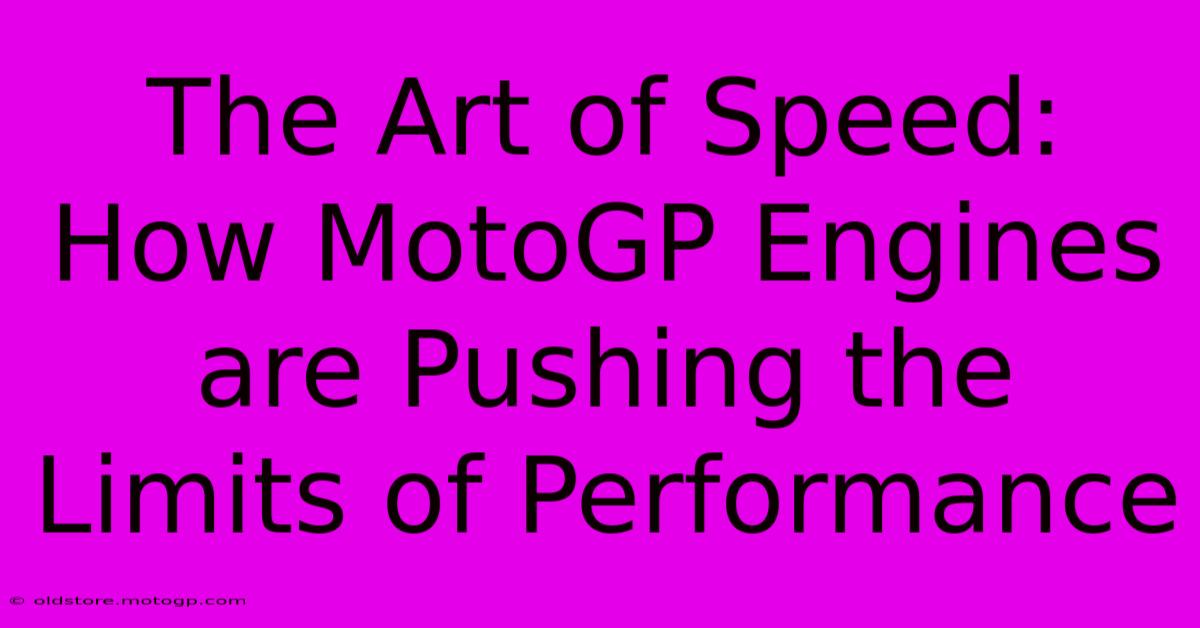The Art Of Speed: How MotoGP Engines Are Pushing The Limits Of Performance

Table of Contents
The Art of Speed: How MotoGP Engines are Pushing the Limits of Performance
MotoGP. The mere mention of the name conjures images of screaming engines, breathtaking speeds, and the ultimate test of rider skill. But behind the spectacle of wheel-to-wheel combat lies a world of cutting-edge engineering, where MotoGP engines represent the pinnacle of performance. This article delves into the heart of these incredible machines, exploring the technologies and innovations that push them to the absolute limit.
The Powerhouse: Engine Specifications and Design
MotoGP bikes boast incredibly powerful engines, currently limited to 1000cc four-stroke prototypes. These aren't your everyday road bike engines; they're meticulously crafted masterpieces designed for maximum horsepower and minimal weight. Key features include:
-
High Revving Capabilities: These engines are designed to operate at incredibly high RPMs, often exceeding 16,000 revolutions per minute, extracting every ounce of power from the fuel-air mixture. This high-revving nature contributes significantly to the bike's acceleration and top speed.
-
Lightweight Construction: Every gram counts in MotoGP. Engines are built using lightweight materials like titanium and magnesium alloys to reduce overall weight, improving handling and agility.
-
Sophisticated Electronics: Modern MotoGP engines rely heavily on sophisticated electronics. Engine control units (ECUs) manage fuel injection, ignition timing, and other parameters in real-time, optimizing performance for different track conditions and riding styles. This includes features like:
- Traction Control: Prevents wheel spin, crucial for maintaining stability during acceleration.
- Wheelie Control: Limits the front wheel from lifting off the ground, ensuring stability.
- Engine Braking Control: Helps manage rear wheel lock-up during braking.
- Launch Control: Assists in achieving optimal acceleration from a standing start.
-
Aerodynamics: The engine's design is intrinsically linked to the overall aerodynamics of the bike. Air intakes and exhaust systems are meticulously engineered to maximize airflow and reduce drag, enhancing both top speed and stability.
Pushing the Boundaries: Technological Advancements
The pursuit of ever-greater performance in MotoGP is a constant arms race of innovation. Key technological advancements pushing the limits include:
-
Pneumatic Valves: Some teams experiment with pneumatic valve actuation systems, allowing for faster valve opening and closing times, further increasing engine speed and power output.
-
Seamless Shift Transmissions: These transmissions allow for incredibly fast gear changes without interrupting power delivery, a crucial advantage during intense racing.
-
Advanced Materials: The use of cutting-edge materials like carbon fiber reinforced polymers (CFRP) and exotic alloys continues to push the boundaries of engine strength and weight reduction.
Beyond the Engine: The Holistic Approach to Performance
It's crucial to understand that engine performance is only one piece of the MotoGP puzzle. Factors like:
- Chassis design: The frame and suspension system are critical for handling and stability at high speeds.
- Aerodynamics: The overall shape of the bike minimizes drag and maximizes downforce.
- Tire technology: Tires provide the crucial link between the bike and the track, with specialized compounds providing grip and stability.
- Rider skill: The skill and experience of the rider are paramount in harnessing the power of the machine.
The combination of all these elements creates the incredible performance we see in MotoGP.
Conclusion: The Future of Speed
MotoGP engines represent the absolute pinnacle of motorcycle engine technology. The constant drive for innovation pushes the boundaries of performance year after year, resulting in ever-faster lap times and more thrilling races. As technology continues to advance, we can only anticipate even more breathtaking advancements in the years to come. The art of speed in MotoGP is a testament to human ingenuity and the relentless pursuit of excellence.

Thank you for visiting our website wich cover about The Art Of Speed: How MotoGP Engines Are Pushing The Limits Of Performance. We hope the information provided has been useful to you. Feel free to contact us if you have any questions or need further assistance. See you next time and dont miss to bookmark.
Featured Posts
-
Motorcycle Design Inspired By Famous Riders
Feb 22, 2025
-
Analyzing The Moto Gp Classification Key Takeaways
Feb 22, 2025
-
Invest In Speed Racing Motor Bikes Await
Feb 22, 2025
-
Free Moto Gp Live Stream Get Closer To The Action
Feb 22, 2025
-
Get Your F1 Austin Parking Sorted
Feb 22, 2025
